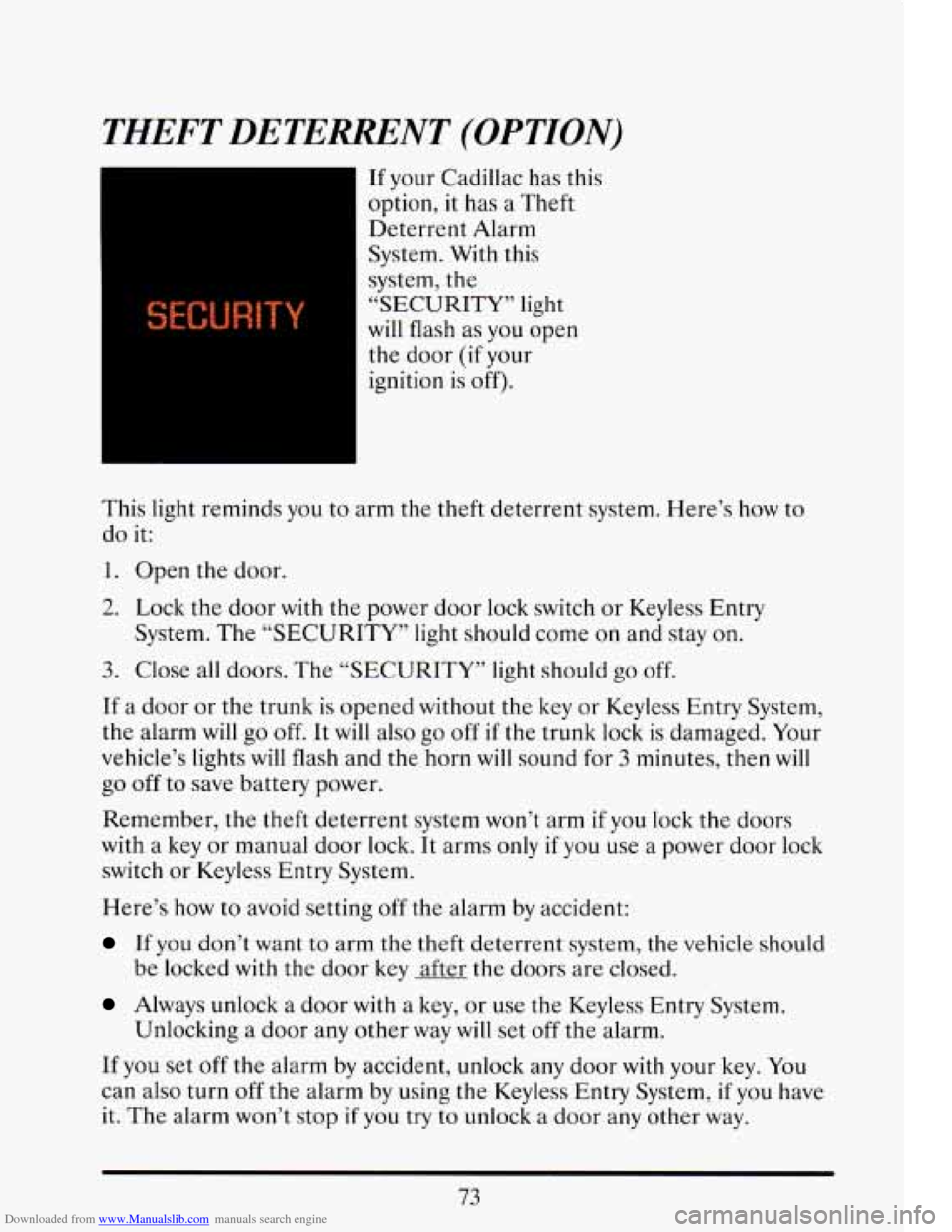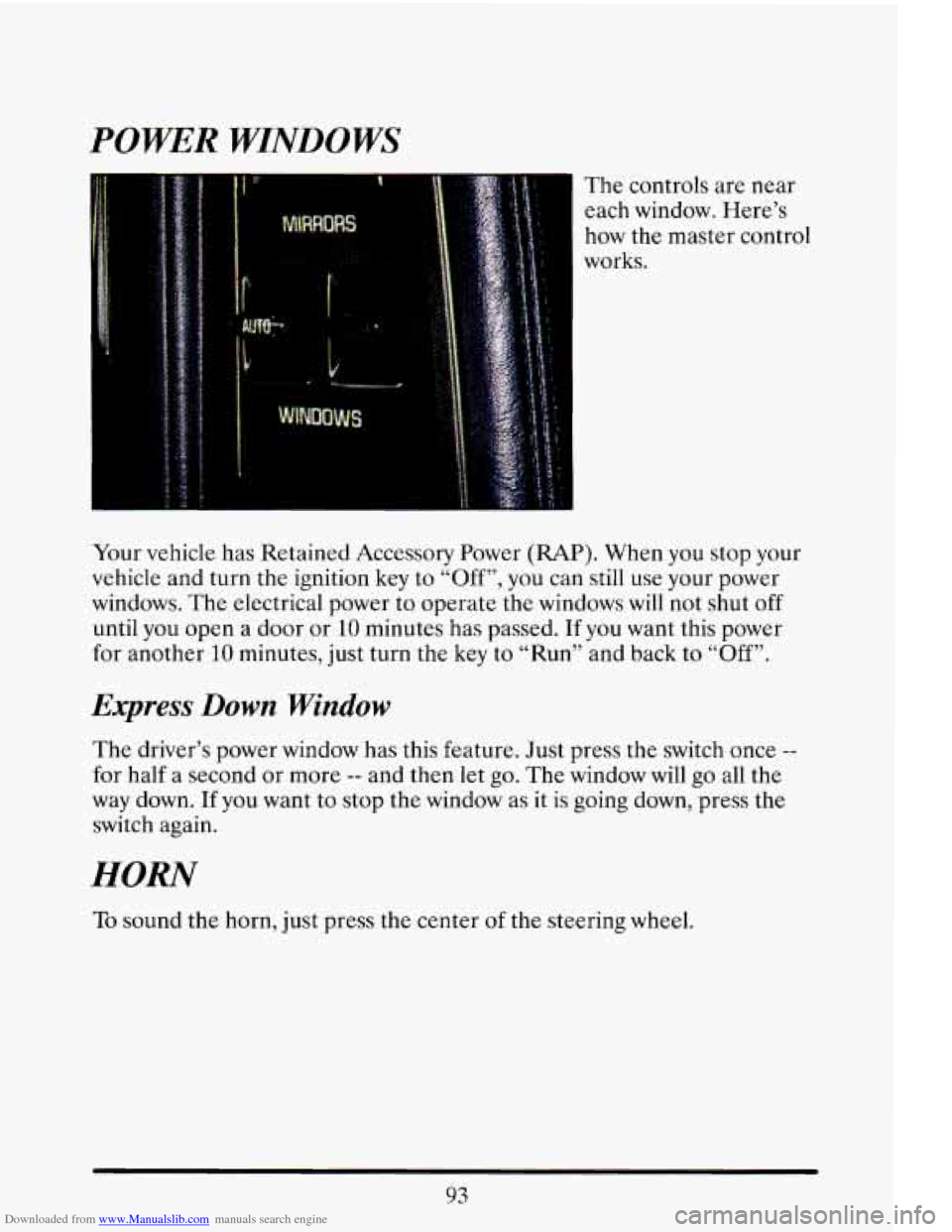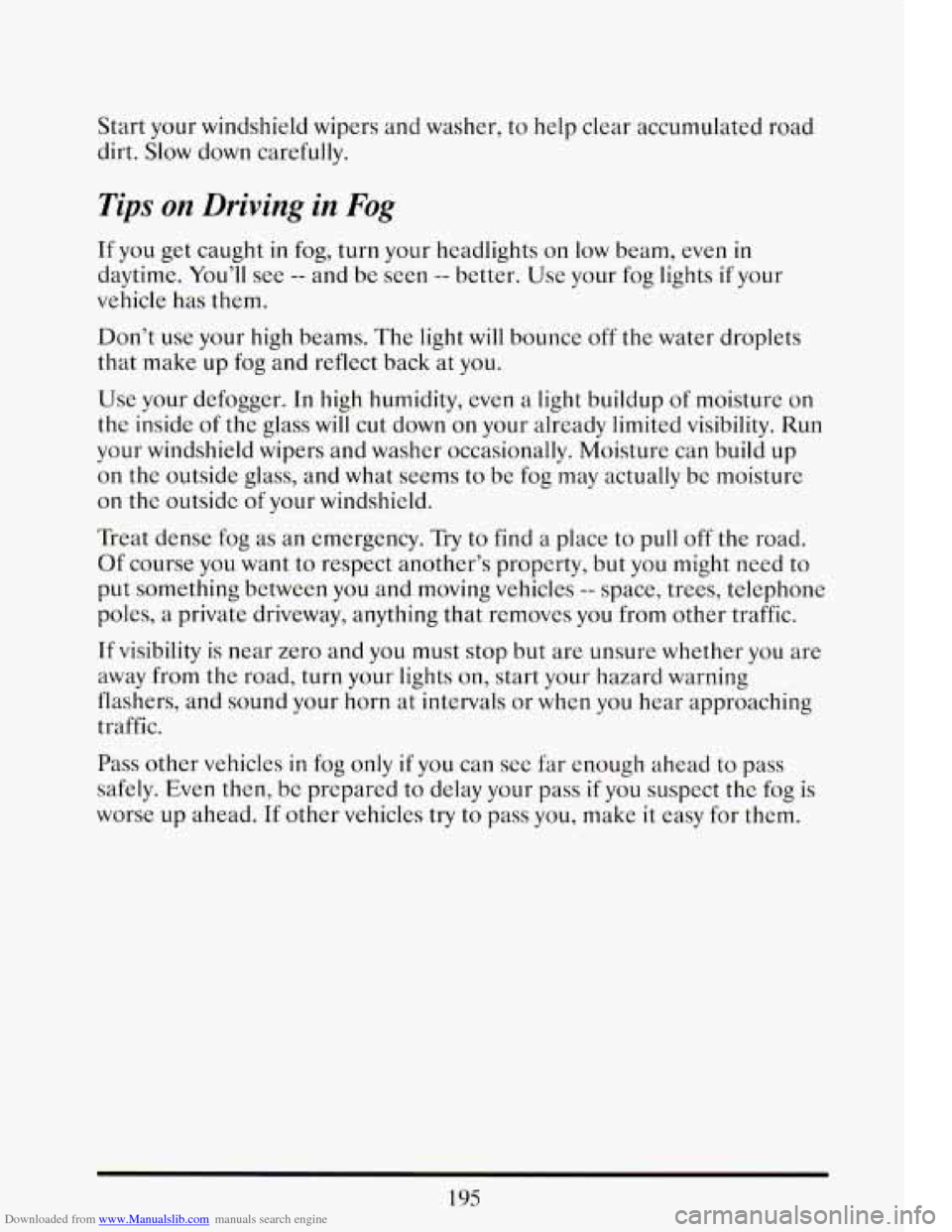1993 CADILLAC ELDORADO horn
[x] Cancel search: hornPage 19 of 398

Downloaded from www.Manualslib.com manuals search engine These symbols are used on warning and indicator lights:
I- I
I
ENGINE COOLANT
TEMPERATURE I
/u/L
BATTERY
CHARGING SYSTEM
u
BRAKE
ENGINE
OIL PRESSURE ENGINE OIL TEMPERATURE
Here are some other
symbols you may see:
A
TRUNK HATCHBACK
RELEASE
U
RADIO SELECTOR
t
l=I
I LIGHTER RADIO VOLUME
1
I HORN 1
RADIATOR
COOLANT
ANTILOCK BRAKE
AIR
CONDITIONING
I
-
SPEAKER
5
Page 87 of 398

Downloaded from www.Manualslib.com manuals search engine THEFT DETERRENT (OPTION)
If your Cadillac has this
option, it has a Theft
Deterrent Alarm System. With this
system, the
“SECURITY” light
will flash as you open
the door (if your
ignition is off).
This
light reminds you to arm the theft deterrent system. Here’s how to
do it:
1. Open the door.
2. Lock the door with the power door lock switch or Keyless Entry
System. The
“SECURITY” light should come on and stay on.
3. Close all doors. The “SECURITY” light should go off.
If a door or the trunk is opened without the key or Keyless Entry System,
the alarm
will go off. It will also go off if the trunk lock is damaged. Your
vehicle’s lights will flash and the horn will sound for 3 minutes, then will
go off to save battery power.
Remember, the theft deterrent system won’t arm
if you lock the doors
with a key or manual door lock.
It arms only if you use a power door lock
switch or Keyless Entry System.
Here’s
how to avoid setting off the alarm by accident:
If you don’t want to arm the theft deterrent system, the vehicle should
be locked with the door key after the doors are closed.
Always unlock a door with a key, or use the Keyless Entry System.
If you set off the alarm by accident, unlock any door with your key. You
can also turn
off the alarm by using the Keyless Entry System, if you have
it. The alarm won’t stop if you try to unlock a door any other way.
Unlocking
a door
any other way will set off the alarm.
73
Page 88 of 398

Downloaded from www.Manualslib.com manuals search engine How to Test The Alarm
0 Roll down your window and lock your vehicle using the power door
Reach in and unlock the door using the manual lock, and open the
If the alarm does not sound when it should, check to see if the horn
works. The horn fuse may
be blown. To replace the fuse, see “Fuses and
Circuit Breakers” in the Index.
lock
or the Keyless Entry System.
door. The horn
will sound and your headlights will flash.
To reduce the possibility of theft, always arm the theft deterrent system
when leaving your vehicle.
PASS-KEY IIm
Your vehicle is equipped with the PASS-Key I1 TM (Personalized
Automotive Security System) theft deterrent system. PASS-Key
I1 TM is a
passive theft deterrent system. This means
you don’t have to do anything
different to arm
or disarm the system. It works when you insert or remove
the key from the ignition. PASS-Key
TM uses a resistor pellet in the
ignition key that matches
a decoder in your vehicle.
When the PASS-Key
TI TM system senses that someone is using the wrong
key, it shuts down the vehicle’s starter
and fuel systems. For about three
minutes, the starter won’t work and fuel won’t go to the engine.
If
someone tries to start your vehicle again or uses another key during this
time, the vehicle will not start. This discourages someone from randomly
trying different keys with different resistor pellcts in
an attempt to make a
match.
The ignition key must
be clean and dry before it’s inserted in the ignition
or the engine may not start.
If the engine does not start and the
“SECURITY” light comes on, the key may be dirty
or wet. Turn the
ignition
off.
If you’re ever driving and the “SECURITY” light comes on and
continues to flash, you get the “PASS-KEY MALFUNCTION” message
and the “STARTING DISABLED” message appears, you
will be able to
restart your engine
if you turn it off. Your PASS-Key TI TM system,
however,
is not working properly and must be serviced bylour Cadillac
dealer. Your vehicle
is not protected by the PASS-Key I1 system.
74
Page 107 of 398

Downloaded from www.Manualslib.com manuals search engine POWER WINDOWS
The controls are near each window. Here’s
how the master control
I works.
Your vehicle has Retained Accessory Power
(RAP). When you stop your
vehicle and turn the ignition key to “Off”, you can still use your power
windows. The electrical power to operate the windows will not shut
off
until you open a door or 10 minutes has passed. If you want this power
for another
10 minutes, just turn the key to “Run” and back to “Off”.
Express Down Window
The driver’s power window has this feature. Just press the switch once --
for half a second or more -- and then let go. The window will go all the
way down. If you want to stop the window as it is going down, press the
switch again.
HORN
To sound the horn, just press the center of the steering wheel.
93
Page 200 of 398

Downloaded from www.Manualslib.com manuals search engine PASSING
The driver of a vehicle about to pass another on a two-lane highway waits
for just the right moment, accelerates, moves around the vehicle ahead,
then goes back into the right lane again.
A simple maneuver?
Not necessarily! Passing another vehicle on a two-lane highway is a
potentially dangerous move, since the passing vehicle occupies the same
lane as oncoming traffic
for several seconds. A miscalculation, an error in
judgment, or a brief surrender to frustration or anger can suddenly put
the passing driver face to face with the worst
of all traffic accidents -- the
head-on collision.
So here are some tips for passing:
“Drive ahead.” Look down the road, to the sides, and to crossroads
for situations that might affect your passing patterns.
If you have any
doubt whatsoever about making
a successful pass, wait for a better
time.
Watch for traffic signs, pavement markings, and lines. If you can see a
sign up ahead that might indicate a turn or an intersection, delay your
pass.
A broken center line usually indicates it’s all right to pass
(providing the road ahead is clear). Never cross
a solid line on your
side
of the lane or a double solid line, even if the road seems empty of
approaching traffic.
If you suspect that the driver of the vehicle you want to pass isn’t
Do not get too close to the vehicle you want to pass while you’re
aware
of your presence, tap the horn
a couple of times before passing.
awaiting an opportunity. For one thing, following
too closely reduces
your area
of vision, especially if you’re following a larger vehicle. Also,
you won’t have adequate space
if the vehicle ahead suddenly slows or
stops. Keep back
a reasonable distance.
When it looks like a chance to pass is coming up, start to accelerate
but stay
in the right lane and don’t get too close. Time your move so
you will be increasing speed as the time comes to move into the other
lane. If the way is clear
to pass, you will have a “running start” that
more than makes up for the distance you would lose by dropping back.
And
if something happens to cause you to cancel your pass, you need
only slow down and drop back again and wait
for another opportunity.
186
Page 209 of 398

Downloaded from www.Manualslib.com manuals search engine Start your windshield wipers and washer, to help clear accumulated road
dirt. Slow down carefully.
Tips on Driving in Fog
If you get caught in fog, turn your headlights on low beam: (en In
daytime. You’ll see -- and be seen -- better. Use your fog lignts if your
vehicle has them.
Don’t use your high beams.
The light will bounce off the water droplets
that make up fog and reflect back at
you.
Use your defogger. In high humidity, even a light buildup of moisture on
the inside
of the glass will cut down on your already limited visibility. Run
your windshield wipers and washer occasionally. Moisture can build up
on the outside glass, and what seems to be fog may actually be moisture
on the outside of your windshield.
Treat dense fog as an emergency. Try to find a place to pull off the road,
Of course you want to respect another’s property, but you might need to
put something between you and moving vehicles
-- space, trees, telephone
poles,
a private driveway, anything that removes you from other traffic.
If visibility is near zero and you must stop but are unsure whether you are.
away from the road, turn your lights
on, start your hazard warning
flashers, and sound your horn at intervals or when you hear approaching
traffic.
Pass other vehicles
in fog only if you can see far enough ahead to pass
safely.
Even then, be preparcd to delay your pass if you suspect the fog is
worse up ahead. If other vehicles try to pass you, make it easy for them.
195
Page 344 of 398

Downloaded from www.Manualslib.com manuals search engine 5
LH MAXI8 FUSE BLOCK
FUSE 1 (50 AMP)
- RETAINED ACCESSORY POWER
(RADIO/WIPERS)
- STARTER
- TRUNK COMR FUSE Ai 1
- ENGINE COMF! FUSES Ai, A3, A5, A7, A9,
All,A13
FUSE 2 (60 AMP)
U.S.A./CANADA Z49/SAUDI
- TRUNK COMP FUSES C1, C3, C5, C7, C9, Cil
- ROAD SENSING SUSPENSION
FUSE 2 EXPORT EXCEPT SAUDI (60 AMP)
- ROAD SENSING SUSPENSION
- REAR FOG LIGHT (EXPORT)
- TRUNK COMP FUSES C1, C3, C5, C7, C9,
C11, C13
CIRCUIT BREAKER 3 (30 AMP)
- FUEL DOOR RELEASE
- TRUNK RELEASE
- LEFT AND RIGHT POWER SEAT
- LEFT AND RIGHT LUMBAR CONTROL
- KEYLESS ENTRY MODULE
- POWER DOOR LOCKS
- HORNS
FUSE 4 (30 AMP)
- POWERTRAIN CONTROL MODULE (PCM)
- ELECTRONIC CLIMATE CONTROL - RAP/ILLUMINATED ENTRY MODULE
- INSTRUMENT PANEL CLUSTER
- PASSKeyB DECODER MODULE
- THEFT DETERRENT
I 50A I m 5
FUSE 5 (60 AMP)
- LEFT AND RIGHT HEATED SEATS
- ELECTRONIC LEVEL CONTROL (ELC)
- TRUNK LID PULL DOWN
- POWER ANTENNA
- REAR DEFOGGER
- LEFT AND RIGHT MIRROR DEFOGGERS
FUSE 6 (60 AMP)
- RETAINED ACCESSORY POWER
(SUNROOF/POWER WINDOWS)
- ENGINE COMF! FUSES C7, Dl, D3, D5
- TRUNK COMF! FUSES Al, A3, A5, A7
RH MAXIB FUSE BLOCK
FUSE 1 (40 AMP)
- TURN/HAZ STOP LP - PARK LIGHTS
FUSE 2 (30 AMP)
- DELCO-BOSEG SPEAKERS
- RADIO CONTROL HEAD
- REMOTE RADIO RECEIVER
CIRCUIT BREAKER 3 (30 AMP)
- FLASH TO PASS FEATURE
- DAYTIME RUNNING LIGHT (DRL)
- HEADLIGHTS
FUSE 4 (40 AMP) HAVAC BLOWER
- HVAC POWER MODULE
- AJC COMPRESSOR
FUSE 5 (50 AMP) ABS
FUSE
6 (50 AMP) COOLING FANS
- ANTILOCK BRAKE PRESSURE VALVE
- COOLING FANS
330